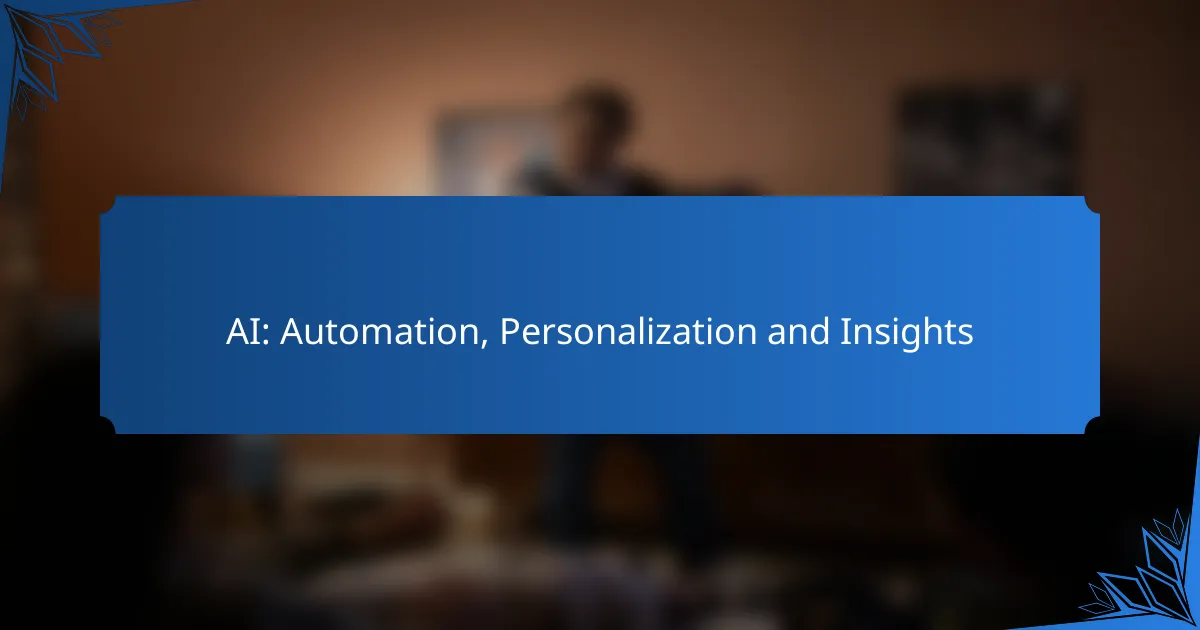Artificial Intelligence (AI) is revolutionizing the landscape of advertising by enhancing automation, personalization, and insights. By streamlining processes and improving targeting accuracy, AI allows advertisers to optimize their campaigns effectively. Additionally, AI-driven personalization tailors content to individual preferences, significantly boosting customer engagement and satisfaction. With advanced data processing capabilities, businesses can derive actionable insights, enabling informed decision-making based on real-time trends and behaviors.
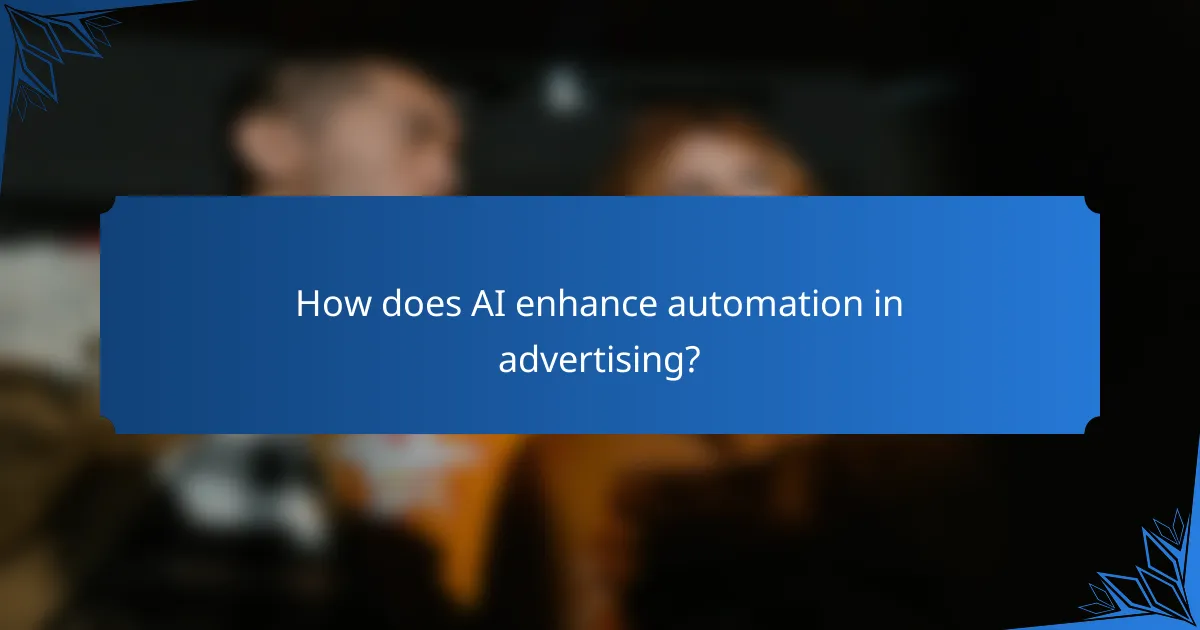
How does AI enhance automation in advertising?
AI enhances automation in advertising by streamlining processes, improving targeting accuracy, and optimizing ad spend. This technology enables advertisers to automate repetitive tasks, analyze vast amounts of data, and make real-time adjustments to campaigns for better performance.
Automated ad placements
Automated ad placements utilize AI algorithms to determine the best platforms and times for displaying ads. By analyzing user behavior and preferences, these systems can place ads where they are most likely to engage the target audience, reducing manual effort and increasing efficiency.
For example, an AI-driven platform may automatically select between social media, search engines, or websites based on historical performance data, ensuring that ads reach potential customers effectively. This approach can lead to higher click-through rates and improved return on investment.
Real-time bidding optimization
Real-time bidding optimization allows advertisers to adjust their bids for ad placements dynamically based on current market conditions. AI systems analyze factors such as competitor bids, audience engagement, and conversion likelihood to recommend optimal bid amounts.
This process can significantly enhance campaign performance by ensuring that advertisers are not overpaying for placements while still maintaining visibility. Advertisers should monitor these recommendations closely to adapt their strategies as market dynamics change.
Campaign performance tracking
AI facilitates comprehensive campaign performance tracking by aggregating data across various channels and providing actionable insights. This enables marketers to assess which ads are performing well and which need adjustments.
Using AI tools, advertisers can visualize metrics such as click-through rates, conversion rates, and customer acquisition costs in real time. Regularly reviewing these insights helps in making informed decisions to optimize ongoing campaigns and allocate budgets more effectively.
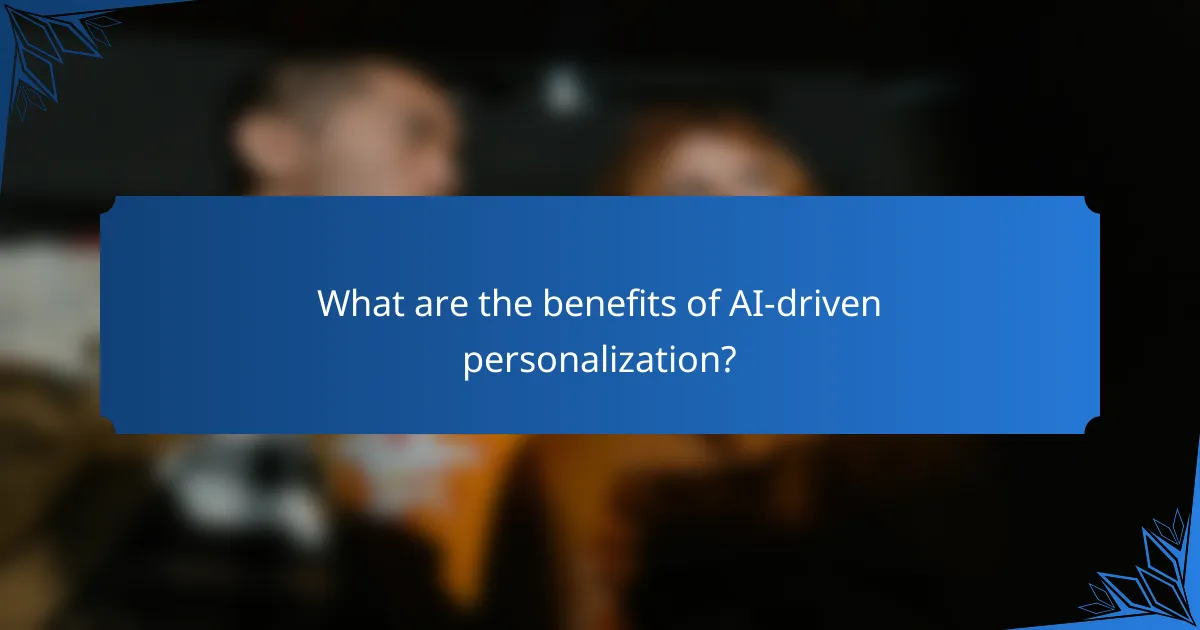
What are the benefits of AI-driven personalization?
AI-driven personalization enhances user experiences by delivering tailored content and recommendations based on individual preferences and behaviors. This approach not only improves customer satisfaction but also boosts engagement and conversion rates across various platforms.
Tailored content recommendations
AI algorithms analyze user data to provide personalized content suggestions, ensuring that users receive information relevant to their interests. For example, streaming services often recommend shows or movies based on viewing history, which can increase user retention and satisfaction.
To implement tailored recommendations effectively, businesses should gather data on user interactions and preferences. Regularly updating algorithms can help maintain accuracy and relevance in suggestions, leading to higher engagement rates.
Dynamic audience segmentation
Dynamic audience segmentation allows businesses to categorize users into specific groups based on real-time data analysis. This enables targeted marketing efforts, as companies can tailor messages and offers to distinct segments, improving the likelihood of conversion.
For instance, an e-commerce platform might segment users based on their shopping behavior, such as frequent buyers or seasonal shoppers. By adjusting marketing strategies to fit these segments, businesses can optimize their outreach and increase sales.
Enhanced user engagement
AI-driven personalization significantly enhances user engagement by creating more relevant and meaningful interactions. Personalized emails, targeted ads, and customized user interfaces can lead to a more satisfying experience, encouraging users to spend more time on a platform.
To maximize engagement, companies should focus on understanding user behavior and preferences. Regularly testing different personalization strategies can help identify what resonates best with the audience, ultimately driving higher engagement and loyalty.
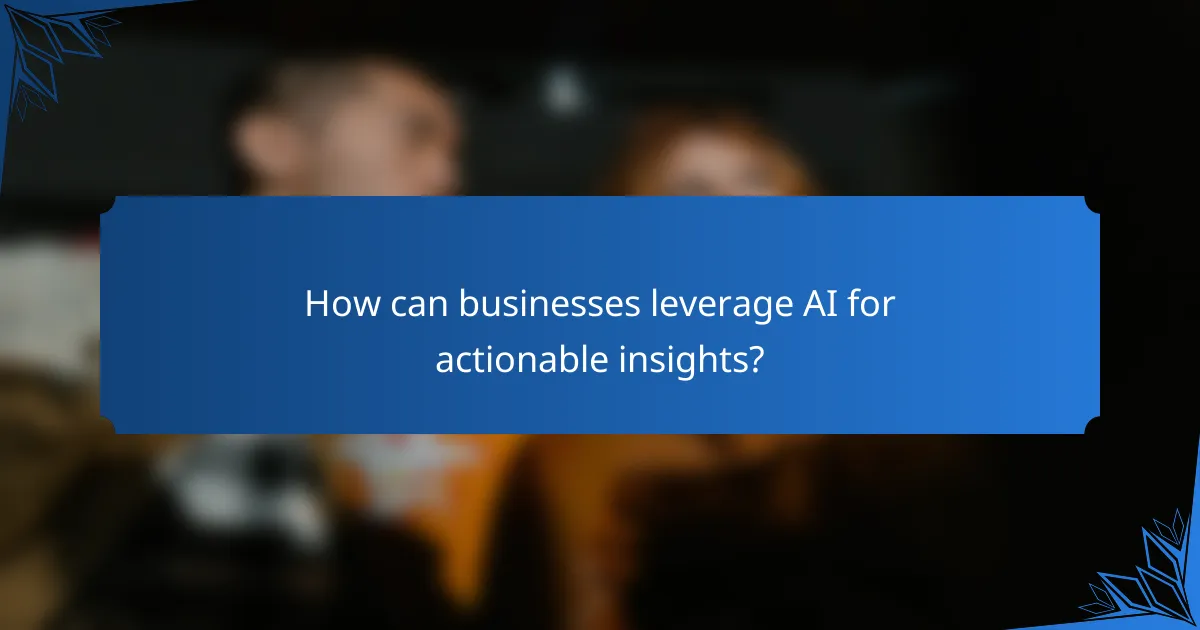
How can businesses leverage AI for actionable insights?
Businesses can leverage AI to derive actionable insights by utilizing advanced data processing techniques that analyze vast amounts of information quickly and accurately. This enables organizations to make informed decisions based on real-time data trends and customer behaviors.
Data analysis and reporting
AI-driven data analysis tools can process large datasets to identify patterns and anomalies that may not be visible through traditional methods. These tools can automate reporting, providing businesses with up-to-date insights that help in strategic planning and operational efficiency.
For effective data analysis, companies should ensure data quality and relevance. Regularly updating datasets and using AI algorithms tailored to specific business needs can enhance the accuracy of reports and insights.
Predictive analytics for trends
Predictive analytics utilizes historical data and machine learning algorithms to forecast future trends. Businesses can use this approach to anticipate market shifts, customer preferences, and potential risks, allowing them to adapt their strategies proactively.
To implement predictive analytics, organizations should focus on collecting comprehensive data and selecting appropriate models. Common pitfalls include overfitting models to past data and neglecting to validate predictions against real-world outcomes.
Customer behavior forecasting
AI can significantly enhance customer behavior forecasting by analyzing purchase history, browsing patterns, and demographic information. This helps businesses tailor their marketing strategies and product offerings to meet customer needs more effectively.
To improve forecasting accuracy, companies should segment their customer base and utilize diverse data sources. Regularly reviewing and adjusting forecasting models based on new data can prevent misalignment with changing consumer behaviors.

What are the prerequisites for implementing AI in advertising?
To successfully implement AI in advertising, organizations need a solid foundation in data infrastructure and skilled personnel. These prerequisites ensure that the AI systems can operate effectively and deliver valuable insights for targeted campaigns.
Data infrastructure readiness
A robust data infrastructure is essential for AI implementation in advertising. This includes having a centralized data repository that can handle large volumes of structured and unstructured data from various sources, such as customer interactions and campaign performance metrics.
Organizations should assess their data quality and accessibility. Implementing data cleaning processes and ensuring compliance with regulations, such as GDPR, are crucial steps. Additionally, consider using cloud-based solutions for scalability and flexibility in data management.
Staff training and expertise
Having a team with the right skills is vital for leveraging AI in advertising. Staff should be trained in data analytics, machine learning, and the specific AI tools being used. This expertise enables them to interpret AI-generated insights and make informed decisions.
Investing in ongoing education and training programs can help keep your team updated on the latest AI trends and technologies. Collaborating with external experts or consultants can also provide valuable guidance during the initial phases of implementation.
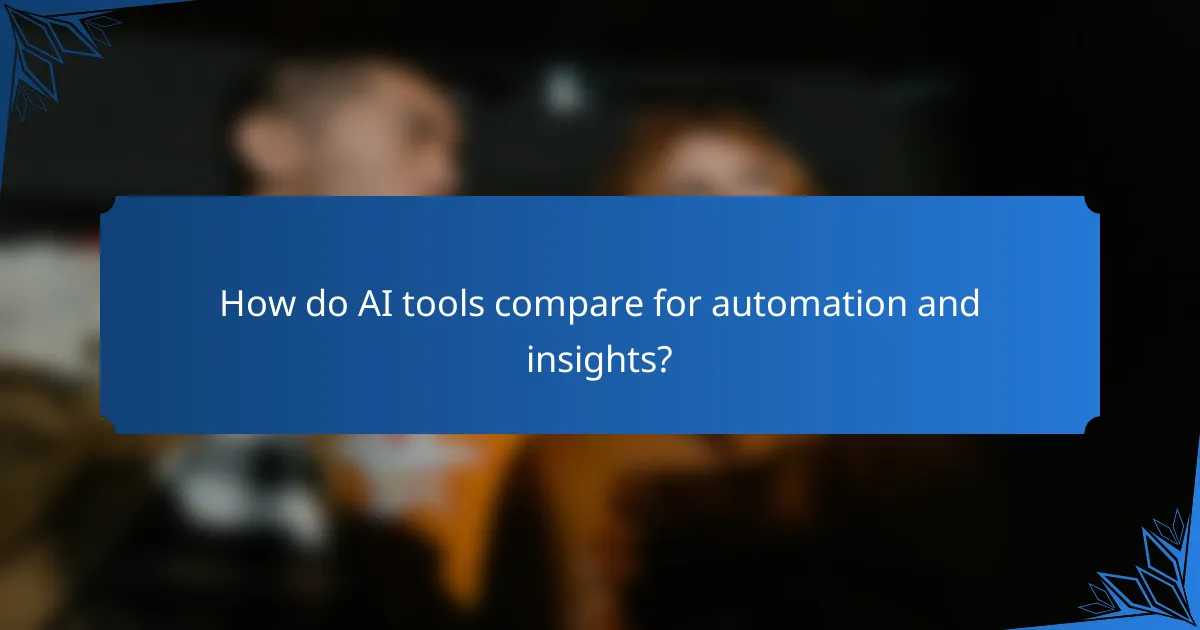
How do AI tools compare for automation and insights?
AI tools vary significantly in their capabilities for automation and insights, impacting how businesses optimize their marketing strategies. Understanding the strengths and weaknesses of each tool can help organizations choose the right solution for their needs.
Google Ads AI features
Google Ads utilizes machine learning to automate bidding strategies and optimize ad placements. Features like Smart Bidding adjust bids in real-time based on various signals, aiming to maximize conversions or target return on ad spend (ROAS).
When using Google Ads, consider the importance of setting clear goals and budgets. The platform’s automation works best when it has sufficient historical data to learn from, so campaigns should run long enough to gather insights.
Adobe Sensei capabilities
Adobe Sensei enhances marketing efforts by providing personalized content recommendations and automating creative processes. It analyzes user behavior to deliver insights that help marketers tailor their campaigns effectively.
For optimal use of Adobe Sensei, ensure your data is well-organized and accessible. This tool excels in environments where creative assets need to be dynamically adjusted based on audience engagement, making it ideal for brands with diverse customer segments.
Facebook Ads AI tools
Facebook Ads employs AI to optimize ad delivery and audience targeting. Its machine learning algorithms analyze user interactions to predict which ads will perform best for specific demographics and interests.
To leverage Facebook Ads effectively, regularly test different ad formats and messages. The platform’s AI can quickly learn from these variations, allowing for better performance over time. Be mindful of Facebook’s advertising policies to avoid disapproval of your ads.

What are emerging trends in AI for advertising?
Emerging trends in AI for advertising focus on automation, personalization, and data-driven insights. These advancements enable brands to create targeted campaigns that resonate with consumers, streamline operations, and enhance overall effectiveness.
Automation in Advertising
Automation in advertising leverages AI to optimize ad placements, manage budgets, and analyze performance metrics. By utilizing machine learning algorithms, advertisers can automate repetitive tasks, allowing teams to focus on strategy and creative development.
For example, programmatic advertising uses AI to buy and sell ad space in real-time, ensuring that ads reach the right audience at the right time. This can significantly reduce costs and increase return on investment (ROI).
Personalization Strategies
Personalization in advertising involves tailoring content and messages to individual consumer preferences and behaviors. AI analyzes vast amounts of data to identify patterns and deliver customized experiences that enhance engagement.
Brands can implement dynamic content that changes based on user interactions, such as personalized email campaigns or targeted social media ads. This approach can lead to higher conversion rates and improved customer loyalty.
Insights and Analytics
AI-driven insights and analytics provide advertisers with deeper understanding of consumer behavior and market trends. By processing large datasets, AI tools can uncover actionable insights that inform campaign strategies and optimize performance.
For instance, predictive analytics can forecast consumer trends, allowing brands to adjust their strategies proactively. Advertisers should regularly review these insights to refine their approaches and stay competitive in the market.
